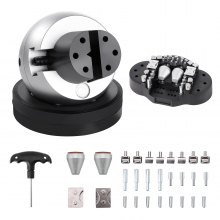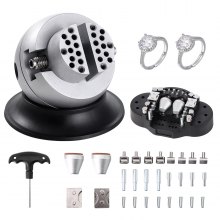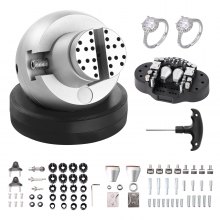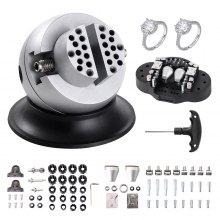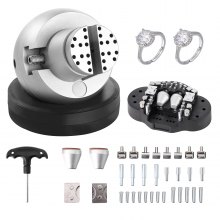VEVOR's Jeweler vise The Small Tool With Big Impact In Craftmanship
The intricate world of craftmanship goes hand-in-hand with two words: precision and details. Artisans rely on many tools to bring their dreams to life. Some of these tools are important in ensuring the finer details of the pieces.
Among these tools, there is a small yet indispensable one - the jewelry vise. Although the size is not a giveaway of its importance, its impact on craftmanship quality and precision is nothing short of astounding.
As artisans strive for perfection, VEVOR, alongside other tool manufacturers, dedicates resources to making high-quality jewelry vises as time-saving allies.
Uses Of A Jeweler Vise
A jeweler's vise is a specialized tool designed to securely hold small and delicate workpieces during various jewelry-making tasks. As unassuming as it is, the vise plays a crucial role in jewelry making. Here are some instances:
Stone Setting
Jewelers use the vise to set a jewelry stone in place. Its primary function is to securely hold small and delicate pieces in place during tasks. Therefore, it provides a stable platform to work on when setting a stone in its place, no matter how small it is.
A jeweler’s vise is a reliable support for jewelers and other artisans that engage in carving and engaging. The worker can easily balance the workpiece, etc, with intricate carvings on it without worrying about shifting or slipping.
Assembly and Repair
A jeweler’s vise helps ensure a jewelry piece or other small items remain stationary and stable when conducting repairs. This makes them indispensable in joining small parts and making delicate adjustments without the risk of movement.
Soldering and Welding
It is essential for a workpiece to maintain a stable position during soldering and welding. These processes deal with heat and can cause accidents or injuries if appropriate care is not taken. A jeweler’s vise gives the artisan the balance they need to minimize the risks of injuries.
Also, they help hold the workpiece firmly in position to ensure the soldering and welding go as planned. The stability in these processes is vital for the workpiece as it may be difficult to correct mistakes made during welding.
Different Materials A Jeweler Vise is Made From
Jeweler’s vises are crafted from different types of materials. Not only is the material versatility essential to enable people to have choices, but the materials also have variable features and different advantages. You should decide on a jeweler vise material, depending on your need and the material’s prospects.
Metals
Metals like aluminum, steel, cast iron, zinc alloy, and brass are typical for making a jewelry vise. These metals are picked for their durability, and they all have distinctive features that give them an edge.
Aluminum is lightweight and corrosion-resistant, making it suitable for portable jeweler’s rust-resistant vises. Steel offers strength and durability, providing a sturdy platform for heavy-duty applications.
Cast iron is robust and durable, making it a solid foundation for tasks like engraving. Zinc alloy is lightweight and durable, making it a good choice for lighter applications that do not compromise strength. Brass is corrosion-resistant and has excellent aesthetic appeal.
Plastic or Nylon
Plastic or nylon jeweler vises are great options in situations where scratching or marring of workpieces is a concern. They have a gentler grip, making them more suitable for delicate materials.
Hardwood
Hardwood, such as beech or oak, can be integrated into constructing jeweler’s vises in traditional or specialized applications. Manufacturers use them for jaws or other non-load-bearing parts to prevent damage to sensitive materials.
Composite Materials
Manufacturers combine various elements like fiberglass or carbon fiber with polymers to make jeweler’s vises that balance strength, durability, lightness and resistance to environmental factors.
The Rise Of DIY Jewelry Making And Its Benefits
The easy accessibility of tools like jewelry vise and other jewelry-making equipment in their portable forms has encouraged DIY jewelry making.
Fortunately, this comes at the right time when DIY jewelry-making has many benefits. Reducing the impacts of consumerism and enabling people to embrace their styles, DIY jewelry making is on the rise. Here are some benefits of DIY jewelry making:
Creative Expression
DIYers carve unique pieces that show personal styles, showcasing their individuality and serve as a means of personal expression.
Cost-Effectiveness
Homemade jewelry can be more cost-effective than buying ready-made ones. This allows people to save more while still having quality jewelry.
Skill Development
DIY jewelry-making encourages the development of new skills. Individuals keep enhancing their basic and advanced skills, including stone setting, metalworking, beading, and wireworking.
Therapeutic and Relaxing
Making something meaningful and beautiful with one’s hands can be therapeutic and relaxing. Many people use DIY jewelry-making to escape the rigors of their minds and get the feeling of achieving.
Why Choose VEVOR?
Jeweler vises are a small but essential jewelry-making tool. Focusing on precision, they help ensure that every detail in a jewelry piece is pronounced, and they also help prevent mistakes. Essentially, jewelers need jewelry vises for total articulation of their jewelry.
With their impact being so pronounced, you have to put enough consideration into choosing the suitable jewelry vise to ensure your workpieces’ quality. You also get the best value for your money when you make an educated decision instead of a random buy.
Fortunately, VEVOR’s jeweler vise satisfies all needs while selling at a competitive price. Affordable and premium quality, VEVOR’s jeweler enables efficiency in all your work. VEVOR has a sterling reputation that we have built for nearly two decades, and the online reviews are a great testament to it.
FAQs About Jeweler Vise
How does a jeweler's vise differ from a regular bench vise?
Unlike the bench task, a jeweler’s vise is designed for smaller and more delicate tasks. It is compact with adjustable jaws for holding tiny objects, making it suitable for greater precision in jewelry-making. A bench vise, on the other hand, is bigger and works for a broader range of tasks.
Can I use a jeweler’s vise for tasks other than jewelry making?
Yes, you can use a jeweler’s vise for other tasks beyond jewelry making. It is versatile, making it suitable for tasks in woodworking, small-scale metalworking, DIY crafts, and any tasks that involve holding a small piece in place.
Can I mount a jeweler’s vise on any work surface?
Many jeweler’s vises are equipped with clamps or mounting bases that you can use to secure them to various work surfaces. These included work benches and tables.






































